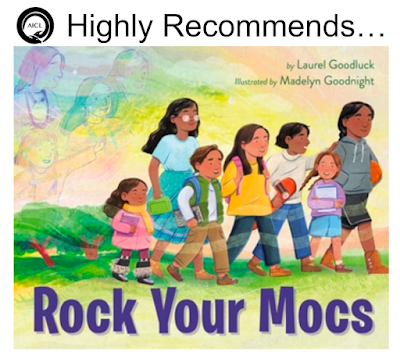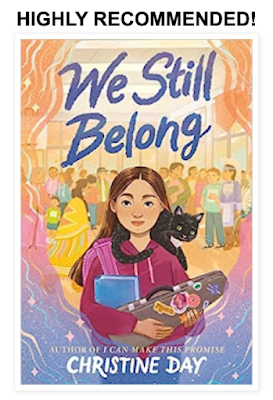August 20, 2023
Dear Teachers,
You (or one of your colleagues) have written to me about Scott O'Dell's Thunder Rolling in the Mountains. Some of your schools have been using it for years and some of your schools use it because it is in the Wit and Wisdom curriculum. Those who have written to me sense that it is not a good choice. They're in Wisconsin. Oregon. California. Tennessee. Louisiana. Ohio. Alabama. New York.
Because this is an Open Letter that may be shared with school administrators and others who don't know who I am, I'll start with some biographical introduction. I'm tribally enrolled at Nambé Owingeh, a sovereign Native Nation in the southwestern part of the US. I started my professional career as a school teacher in Albuquerque and later got a PhD in Education at the University of Illinois Urbana Champaign. My research and publications are focused on depictions of Native peoples in children's and young adult books.
At Illinois I served as president of the Native student group where we focused on three goals: a Native American House that would support the needs of Native students, an American Indian Studies program that would hire Native professors and provide all students with courses on Native peoples, and for a change in the university's mascot (it was "Chief Illiniwek"). I received my doctorate in 2000 and held a post doctoral position from 2002-2004. In 2002, the Native House was founded. In 2005, the Board of Trustees approved the American Indian Studies Program. In 2007, the university got rid of the mascot.
Some of you may be a bit confused because you've been thinking of us as "tribes." You were educated and socialized to think of us as tribes but, in fact, the tribes are hundreds of distinct nations of Native people. When Europeans came onto our homelands hundreds of years ago, they knew we were nations. And when the U.S. became a nation, its leaders knew we were nations, too. There's hundreds of treaties between various Native Nations and those who came onto our lands.
Who I am, what I know as a Native woman, and what I study shapes what you find in my book chapters, research and professional articles, and on my blog,
American Indians in Children's Literature. A few weeks ago, I did
a "close read" of Thunder Rolling in the Mountains. When I do a close read, I write up notes as I read. I ask questions. If there are misrepresentations or bias or factual errors, I note them, and then I share the notes. Anybody can get a copy of the book, start reading, and look over my notes as they do.
O'Dell's book was published in 1992 by Houghton Mifflin. You may have a copy with a different cover because it has been reissued many times since then.
In textbooks and professional guides for those who teach, study, review or critique children's books, there are some common elements. In From Cover to Cover, Kathleen T. Horning writes that we should try to determine what sort of authority the author has. Generally it means that we should see if the author has training or expertise on the topic the book is about.
Given my identity and area of study I also ask if the author is Native.
The cover of Thunder Rolling in the Mountains lists two authors: Scott O'Dell and Elizabeth Hall (she was O'Dell's wife). My guess is that most teachers recognize the name, "Scott O'Dell," because they probably read his books when they were in school. They may know he won awards for some of his books.
But returning to the question: did he have training or expertise on Native peoples? Was he Native?
Scott O'Dell was not Native and did not have a degree that might have given him the authority that Horning asked us to look for. At his website, he wrote that he went to three different colleges but I don't see any indication of what he studied at them, and he also doesn't say that he graduated from any of them. Author identity and expertise are a starting point. What the author creates is important, too.
When I did my close read of Thunder Rolling in the Mountains, I saw O'Dell used "moons" and "suns" to signify passage of time. Because I've studied children's books about Native peoples for over 30 years I've seen other non-Native writers do it. I wondered if O'Dell did it in his other books.
He wrote several children's books about Native people of different tribal nations. Those nations include ones on the west coast, the southwest, and the northwest. They have very different histories, religions, songs, and stories. And, they spoke different languages. Let's look at four of them:
- Island of the Blue Dolphins came out in 1960. It is set in the 1850s. O'Dell based it on a Native woman whose people lived on an island off the coast of California. In the mid 1830s, they were taken to the mainland. She remained (or was left) on the island, living alone until 1853 when she was also taken to the mainland. She and her people are called "Nicolenos" because their island was called "San Nicolas Island" by White people. I wonder what they called their island, and what they called themselves--in their language?
- Sing Down the Moon came out in 1970. Set in the 1860s, it is about the Navajo people (some prefer to be called Diné which is their word for "the people") and their forced removal from Diné Bikéyah, or Dinétah (their homeland). Their removal is commonly called The Long Walk.
- Streams to the River, River to the Sea: A Novel of Sacagawea came out in 1986. As the title indicates, it is about Sacagawea as a member of Lewis and Clark's expedition in 1804.
- Thunder Rolling in the Mountains came out in 1992. It is set in the 1870s and is about Chief Joseph, a Nez Perce leader, and his people being forced off of their homelands. O'Dell tells us about it through the perspective of his daughter.
O'Dell (a white male) wrote from the point of view of female characters of four different tribal nations who lived in the 1800s--a very different era. To do so, he had to imagine and create the thoughts, emotions, and dialog for characters (some of them were actual people) whose first language was not English and whose culture was different from his. Let's look at some of what he wrote.
In chapter one of Thunder Rolling in the Mountains, O'Dell has Sound of Running Feet (the main character) thinking:
I had not ridden the trail for many moons.
And a few sentences later, another character says:
"We told our mothers before we left to dig roots that we would be gone three suns."
In chapter one of Island of the Blue Dolphins, O'Dell has Karana (the main character) thinking this about her brother:
He was small for one who had lived so many suns and moons.
In chapter 10 of Streams to the River, River to the Sea: A Novel of Sacagawea, O'Dell has Sacagawea saying (about Charbonneau), that
"He will be gone for many suns."
In chapter 20 of Sing Down the Moon, O'Dell's main character, Bright Moon, is thinking:
Within the rising and waning of five moons my baby would be born.
In each of those sentences, all the words are English ones. O'Dell could have said day/days or night/nights instead of moons/suns. Why did he use "suns" and "moons" instead?
I suspect it started with James Fenimore Cooper. A lot of the things Cooper came up with when he wrote The Last of the Mohicans in 1826 have been used by other writers. In chapter three, he has
"We said the country should be ours from the place where the water runs up no longer on this stream, to a river twenty sun's journey toward the summer."
Earlier in the chapter, we see this:
"Even your traditions make the case in my favor, Chingachgook," he said, speaking in the tongue which was known to all the natives who formerly inhabited the country between the Hudson and the Potomac, and of which we shall give a free translation for the benefit of the reader; endeavoring, at the same time, to preserve some of the peculiarities, both of the individual and of the language."
Peculiarities? What might those be? I think his use of "sun's" is one of those peculiarities. As I think about what Cooper meant, I realize it really doesn't matter. What matters is that others--like O'Dell--use it, too, as if Native people of four entirely different nations in entirely different locations and time periods, used it.
What O'Dell did, I think, is a failure. Teachers who assign his books may inadvertently be encouraging kids to think that many Native people used sun/moon instead of night/day to mark time. That's not educational!
I'm not criticizing teachers for using Thunder Rolling in the Mountain (or one of his other books) if it is part of what your school requires. I am, however, asking you to consider studying it, and talking with your fellow teachers and administrators about the book. And if you decide his books cannot be used in your classroom, I hope you'll write to your district's curriculum officer and to the entities (like the company that publishes the Wit and Wisdom curriculum) to ask them to stop using the book, and that your letter will explain why you think the book is mis-educating students.
When I started this post, I titled it "Dear Teachers: An Open Letter about Scott O'Dell and Elizabeth Hall's THUNDER ROLLING IN THE MOUNTAINS, and I meant to be comprehensive, addressing most of the things I noted in my close read. But as I worked on it, I felt overwhelmed. I decided I didn't want to overwhelm you. Instead, I decided to present my research as a series, titled "Dear Teachers: A Series of Open Letters about Scott O'Dell's Books. Open Letter #1 - Suns and Moons." I welcome your comments and if you prefer to write to me directly, you can find my email address in the
contact link. I will not share what you say without your permission.
I think my second letter in the series will be about quotes. O'Dell has characters speaking certain words and phrases that real people said, and that are findable in books and other historical records.
That's all--for now,
Debbie























